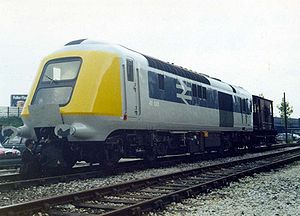British Rail Class 41 (HST)
| British Rail Class 41 (HST) | |||||||||||||||||||||||||||||||||
|---|---|---|---|---|---|---|---|---|---|---|---|---|---|---|---|---|---|---|---|---|---|---|---|---|---|---|---|---|---|---|---|---|---|
 41001 at the Railway Technical Centre in 1972 | |||||||||||||||||||||||||||||||||
| |||||||||||||||||||||||||||||||||
| |||||||||||||||||||||||||||||||||
| |||||||||||||||||||||||||||||||||
| |||||||||||||||||||||||||||||||||
The British Rail Class 41 were two powercars built in 1972 by British Rail Engineering Limited's Crewe Works to operate with the prototype High Speed Train (HST) with Mark 3 carriages.
History
[edit]

Two power cars were built in 1972 by British Rail Engineering Limited's Crewe Works, numbered 41001 and 41002.[3] They initially conducted tests on the East Coast Main Line with the set based at Neville Hill TMD.[4][5]
Having accumulated more than 100,000 miles (160,000 km), including setting a diesel train speed record of 143 mph (230 km/h) between Northallerton and Thirsk in June 1973, they moved to the Great Western Main Line in 1974.[4][6] On 5 May 1975, both entered revenue service on Great Western services between London Paddington and Bristol Temple Meads / Weston-super-Mare.[7][8]
After the Class 252 re-classification they were renumbered into the carriage numbering range as 43000 and 43001.
After being replaced by production Class 43 HST powercars in the early 1980s, both were allocated to the Railway Technical Centre and used in various high speed trials associated with the Advanced Passenger Train and InterCity 225 projects. In December 1990, 41002 was scrapped by CF Booth in Rotherham, while 41001 was restored cosmetically and donated to the National Railway Museum.
In 2011, the National Railway Museum agreed a lease with the 125 Group that resulted in 41001 moving from York to Neville Hill TMD in March 2012 to be restored to operational condition.[9][10][11] As part of this move, it was re-registered on TOPS as Class 43/9 locomotive 43000.[12]
Upon completion it was based at the Great Central Railway (Nottingham). In November 2014, 41001 hauled its first passenger train since 1976, a special named the Screaming Valenta, using a short-formed East Midlands Trains HST set with a Class 43 on the other end.[13]
After suffering engine problems at the Keighley & Worth Valley Railway in May 2019, it was moved to Neville Hill TMD for repairs.[14][15]
In October 2019, the National Railway Museum announced it had terminated the loan agreement, citing serious contract breaches. Although that was disputed by the 125 Group, 41001 was returned to the museum in November 2019.[16]
References
[edit]- ^ Haresnape, Brian (June 1983). British Rail Fleet Survey 5: High Speed Trains. Shepperton: Ian Allan Publishing. p. 41. ISBN 0-7110-1297-0. GE/0683.
- ^ Maclean, Stuart (4 June 2014). "NRM HST prototype 41001". National Preservation. Archived from the original on 26 November 2015. Retrieved 25 November 2015.
has its original 110 V/1000 V Auxiliary Alternator fitted so isn't compatible with production HST electronics. … standard DC ETH rather than the 415 V AC of an HST so more useful for a role on preserved railways. … not being able to provide train supply to an HST set,
- ^ "Track Tests This Month for High-Speed Train". The Railway Magazine. No. 854. June 1972. pp. 288–291.
- ^ a b "Evolution trials of HST". The Railway Magazine. No. 880. August 1974. p. 379.
- ^ British Railways Locoshed Book 1974 edition. Shepperton: Ian Allan Publishing. 1974. p. 30. ISBN 0-7110-0558-3.
- ^ "Fastest Ever by Diesel". The Railway Magazine. No. 868. August 1973. p. 397.
- ^ {{cite magazine|title=HST in revenue earning service|magazine=[[The Railway Magazine]|issue=890|date=June 1975|page=310}}
- ^ "Britain's HST Enters Revenue Service". Railway Age. No. 9 June 1975. p. 60.
- ^ Project Miller (12 May 2011). "(untitled)" (Press release). Archived from the original on 24 March 2012. Retrieved 26 May 2011.
- ^ "Prototype HST to run again". The Railway Magazine. No. 1323. July 2011. p. 11.
- ^ "Pioneer HST power car at Leeds to aid restoration". Rail Magazine. No. 694. 18 April 2012. p. 12.
- ^ "Power trip". Rail Magazine. No. 698. 13 June 2012. pp. 44–47.
- ^ "In Brief". Rail Express. No. 224. January 2015. p. 36. ISSN 1362-234X.
- ^ "41001 Withdrawn from all forthcoming events". 125 Group. 7 May 2019. Archived from the original on 3 March 2021. Retrieved 14 May 2019.
- ^ "Prototype HST moves to Neville Hill". Rail Express. No. 279. August 2019. p. 77.
- ^ "Prototype HST Power Car 41001 to return to York". 125 Group. 9 October 2019. Archived from the original on 6 January 2021. Retrieved 15 October 2019.
Further reading
[edit]- Marsden, Colin J.; Fenn, Graham B. (1988). British Rail Main Line Diesel Locomotives. Sparkford: Haynes. pp. 168–171. ISBN 9780860933182. OCLC 17916362.
- B.R. Mainline Diesel Locomotive Diagram Book MT/25 (PDF). Derby: British Railways Board. March 1973. pp. 13, 114 (per pdf) – via Barrowmore MRG.
